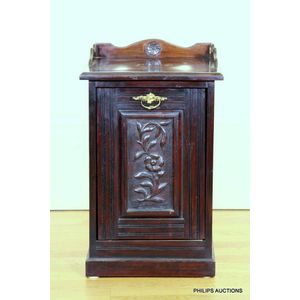French Boulle Pedestal with Gilt Mask and Brass Pierced Work
You must be a subscriber, and be logged in to view price and dealer details.
Subscribe Now to view actual auction price for this item
When you subscribe, you have the option of setting the currency in which to display prices to $Au, $US, $NZ or Stg.
- Pierced Decoration - Ornamental woodwork with part of the background cut through and removed to produce an open-work pattern.
- Ebonised - Timber that has been stained or lacquered black in imitation of ebony. The process has been used since the Renaissance, but is most commonly found in late 19th century furniture, sometimes gilded and turned in imitation of bamboo. Furniture with an ebonised finish is not currently in vogue, and this is reflected in the price for such pieces.
- Boulle - Boulle work is the name given to tortoiseshell and metal inlay using brass and sometimes silver, found on furniture and smaller wooden objects. It originated in Italy but was developed by Frenchman Andre Charles Boulle (1642 - 1732) under Louis XIV.
Boulle was appointed Royal Cainet Maker to Louis XIV and designed furniture and clockcases for the monarch.
In preparation, the tortoiseshell and metal were cut together following a design, using a fine fret saw.
In the application of the Boulle, the carcase of piece of furniture was covered with the tortoiseshell which in turn was inlaid with the matched designs in metal, which in turn was elaborately engraved.
The use of Boulle work furniture continued mainly in France until the 19th century.
This item has been included into following indexes:
- Boulle - furniture, sundry items 24
-
pedestals and columns, material
- gilt and gilded 104
- wooden, other 154
Visually similar items

A French kingwood parquetry and ebonised revolving cigar case. 24 cm high.

An Edwardian timber coal box, early 20th century, the ebonised box with a three quarter gallery, panelled sides and fall front with a relief carved floral motif and an ornate brass handle, metal liner enclosed. Height 59 cm, width 36 cm, depth 35 cm

A good highly decorative George III black lacquer chinoiserie longcase clock, the brass dial with Roman numerals, subsidiary seconds dial and date aperture, the maker noted 'Andren Moran London', applied pierced, scroll and mask cast panels to the quadrant

An early 20th century Chinese octagonal table profusely carved decoration to the sides and top, painted. Height 58 cm, diameter 56 cm
